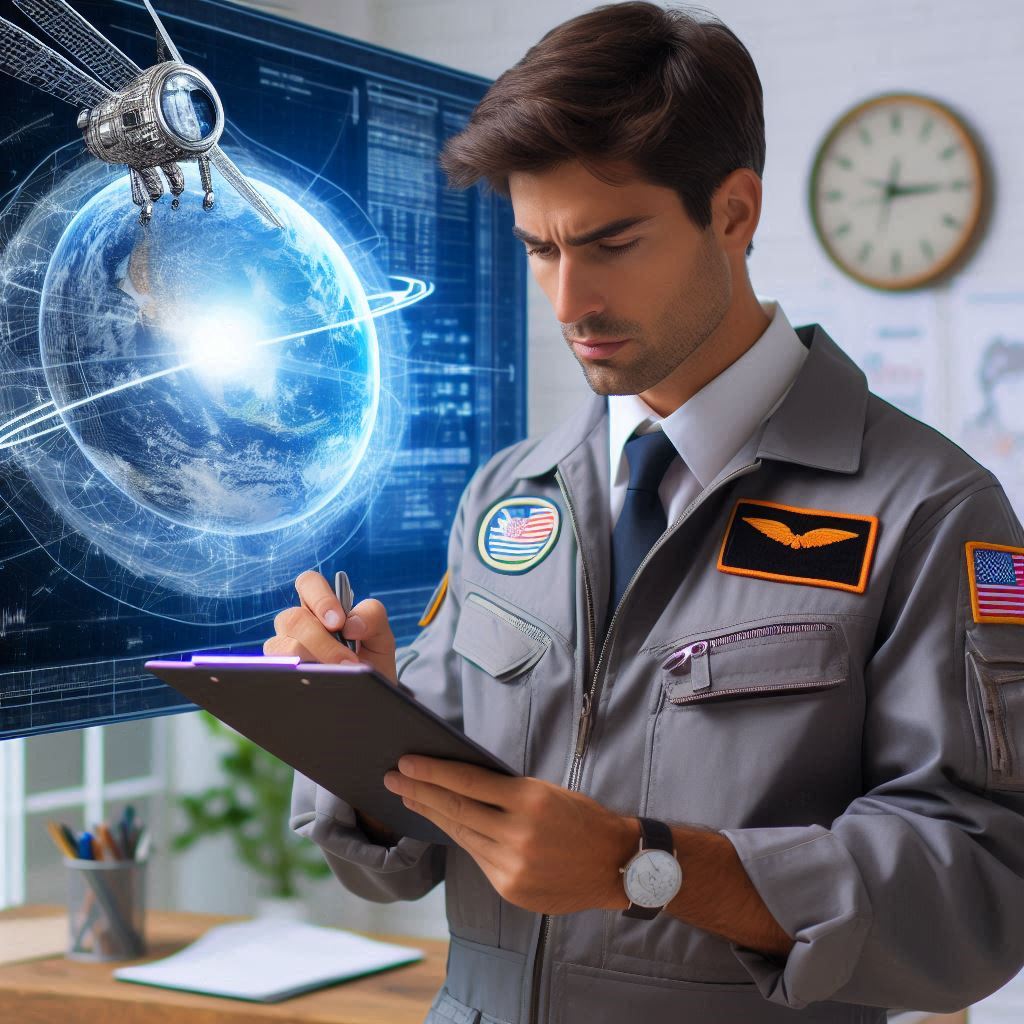Introduction
Aerospace engineering is a dynamic and multifaceted field dedicated to the design, development, and testing of aircraft and spacecraft.
As a critical sector, it plays a pivotal role in modern technology and global advancements.
Aerospace engineers are at the forefront of enhancing air travel, advancing space exploration, and improving defense systems.
The importance of aerospace engineering is evident in its impact on technology and innovation.
It influences everything from commercial aviation and space missions to military defense and satellite communications.
This field not only drives advancements in transportation and safety but also contributes to scientific discoveries and national security.
Career paths in aerospace engineering are diverse and rewarding.
Professionals can specialize in various areas such as aerodynamics, propulsion, avionics, and materials science.
They may work for government agencies like NASA, private aerospace companies, or defense contractors.
Roles can range from designing cutting-edge aircraft to developing spacecraft for interplanetary missions.
This blog explores the various career opportunities within aerospace engineering, highlighting the unique challenges and growth potential in each path.
Understanding these options can guide you in navigating and succeeding in this exciting and evolving field.
Education and Skills Required
Importance of a Strong Foundation in Math, Physics, and Engineering
A strong foundation in math, physics, and engineering is crucial for a successful career in aerospace engineering.
Math skills are essential for solving complex equations and analyzing data.
Physics provides an understanding of forces, motion, and energy, which are fundamental in aerospace design.
Engineering principles guide the application of these sciences to real-world problems.
Without these core skills, tackling the challenges of aerospace projects would be significantly more difficult.
Bachelor‘s Degree in Aerospace Engineering or Related Field
A bachelor‘s degree in aerospace engineering or a related field is the first step in pursuing a career in aerospace.
This degree offers a comprehensive education in key areas like aerodynamics, propulsion, and structures.
Coursework includes subjects such as fluid dynamics, materials science, and control systems.
A strong academic background prepares students for the technical demands of the field.
Many entry-level positions in aerospace require this degree as a minimum qualification.
Advanced Degrees for Higher-Level Positions
Advanced degrees are often necessary for higher-level positions in aerospace engineering.
A master‘s degree allows for specialization in areas such as propulsion, avionics, or spacecraft design.
It also opens doors to research opportunities and leadership roles.
A Ph.D. is essential for careers in academia or advanced research.
This degree involves conducting original research and contributing to the field‘s knowledge base.
Advanced degrees enhance career prospects and provide a competitive edge in the job market.
Importance of Internships and Hands-On Experience
Internships and hands-on experience are vital for a successful aerospace engineering career.
They offer practical experience and apply theoretical knowledge to real-world problems.
Internships provide opportunities to work with industry professionals and gain insights into aerospace projects.
Hands-on experience helps in developing technical skills and understanding industry practices.
Many employers value practical experience alongside academic qualifications.
Internships often lead to job offers and provide valuable networking opportunities.
A career in aerospace engineering requires a strong foundation in math, physics, and engineering.
These core subjects are essential for understanding and solving complex aerospace challenges.
A bachelor‘s degree in aerospace engineering or a related field is necessary for entry-level positions.
Advanced degrees, such as a master‘s or Ph.D., are important for higher-level roles and specialized careers.
Internships and hands-on experience play a crucial role in preparing for a career in aerospace engineering.
They provide practical skills and industry insights, enhancing job prospects.
Combining a solid academic background with real-world experience leads to a successful and rewarding career in aerospace engineering.
Aircraft Design and Development
Role of Aerospace Engineers in Designing and Developing Aircraft
Aerospace engineers play a crucial role in designing and developing aircraft.
They work on creating efficient and safe flying machines.
Engineers are involved in every stage, from conceptual design to testing and production.
Their responsibilities include improving aerodynamics, enhancing fuel efficiency, and ensuring structural integrity.
Engineers collaborate with teams to integrate various systems into the aircraft.
They address challenges such as weight reduction, performance optimization, and safety compliance.
Their work ensures that aircraft meet stringent industry standards and regulations.
Skills and Knowledge Required for This Career Path
To excel in aerospace engineering, several skills and knowledge areas are essential.
Strong proficiency in mathematics and physics is fundamental.
Engineers use these skills to solve complex problems related to forces, motion, and energy.
Proficiency in computer-aided design (CAD) software is crucial for creating detailed aircraft models.
Engineers must also understand materials science to select and test appropriate materials.
Knowledge of propulsion systems, aerodynamics, and structural analysis is critical for effective design and development.
Areas of Specialization Within Aircraft Design and Development
Aerospace engineering offers several areas of specialization within aircraft design and development.
One major area is aerodynamics, focusing on improving airflow and reducing drag.
Aerodynamics specialists work to enhance aircraft performance and fuel efficiency.
Another area is propulsion systems, where engineers design and optimize engines and propulsion technologies.
They work on jet engines, turbofans, and alternative propulsion methods.
Structures and materials is another specialization.
Engineers in this field focus on designing and testing aircraft structures to ensure strength and durability.
They work on optimizing material usage and reducing weight while maintaining safety.
Systems engineering is another specialization, involving the integration of various aircraft systems.
Systems engineers ensure that avionics, navigation, and control systems work seamlessly together.
They address the challenges of integrating complex technologies into a cohesive and functional aircraft.
Job Opportunities in the Aerospace Industry
The aerospace industry offers diverse job opportunities for aerospace engineers.
Positions are available with aircraft manufacturers, such as Boeing and Airbus.
Engineers may work on designing new aircraft models, improving existing ones, or conducting research.
Government agencies like NASA and the Department of Defense also employ aerospace engineers.
These positions often involve working on cutting-edge projects related to space exploration and national defense.
Aerospace engineers may also find opportunities with defense contractors, focusing on military aircraft and systems.
They may work on developing advanced fighter jets, surveillance aircraft, and unmanned aerial vehicles (UAVs).
Additionally, aerospace engineers can work in consulting roles, offering expertise on various projects and technical challenges.
They may also pursue careers in academia, conducting research and teaching future engineers.
Aerospace engineers play a vital role in designing and developing aircraft, ensuring they are efficient, safe, and innovative.
They need strong skills in mathematics, physics, and CAD software, along with specialized knowledge in aerodynamics, propulsion systems, and structural design.
Specializations within aircraft design offer various career paths, including aerodynamics, propulsion, and systems engineering.
The aerospace industry provides diverse job opportunities, from working with major manufacturers to government agencies and defense contractors.
By combining technical expertise with a passion for aviation and space exploration, aerospace engineers contribute to advancing technology and shaping the future of flight.
Space Exploration and Satellite Technology
Opportunities for Aerospace Engineers in the Field of Space Exploration
Aerospace engineers play a crucial role in space exploration.
They contribute to designing spacecraft, satellites, and related technologies.
Opportunities in this field are diverse and exciting, ranging from working on Mars rovers to developing satellite communication systems.
Engineers involved in space exploration work with cutting-edge technologies and innovative designs.
They are integral to the development of missions that explore outer space and advance our understanding of the universe.
Careers in this area often involve collaboration with organizations like NASA, SpaceX, and other space agencies.
Role in Designing and Building Satellites
One significant area of work for aerospace engineers is the design and construction of satellites.
Satellites serve various purposes, including communication, weather monitoring, and Earth observation.
Engineers design these complex systems to operate reliably in the harsh environment of space.
The process involves creating detailed designs, selecting materials, and testing components to ensure they withstand space conditions.
Engineers work on satellite systems from concept through to launch and operational phases.
They ensure that satellites function correctly and meet mission objectives.
Designing satellites requires expertise in areas such as propulsion, thermal control, and electronics.
Engineers must address challenges like power management, thermal regulation, and communication systems.
Successful satellite design is critical for advancing technologies and providing valuable data for various applications.
Impact of Aerospace Engineers on Advancements in Space Technology
Aerospace engineers significantly impact advancements in space technology.
Their work drives innovations in spacecraft design, propulsion systems, and satellite technology.
Engineers contribute to the development of new technologies that enhance space exploration and improve our understanding of space.
Transform Your Career Today
Unlock a personalized career strategy that drives real results. Get tailored advice and a roadmap designed just for you.
Start NowFor example, engineers are developing more efficient propulsion systems that enable deeper space exploration.
Advances in materials and manufacturing techniques also contribute to building more robust and reliable spacecraft.
These innovations lead to new missions, scientific discoveries, and technological breakthroughs.
The impact of aerospace engineers extends beyond space exploration.
Their work influences other industries by advancing technology that benefits everyday life.
Innovations in satellite technology, for instance, have led to improvements in communication, navigation, and Earth observation.
Challenges and Opportunities in the Space Industry
The space industry presents both challenges and opportunities for aerospace engineers.
Challenges include the high cost of space missions, complex system requirements, and the need for rigorous testing.
Engineers must solve problems related to spacecraft durability, mission reliability, and cost-effectiveness.
However, the space industry also offers exciting opportunities.
The growth of private space companies and international collaborations creates new avenues for innovation and career advancement.
Engineers can work on groundbreaking projects like commercial space travel, asteroid mining, and interplanetary exploration.
The evolving landscape of the space industry provides opportunities for engineers to contribute to transformative technologies.
Engineers play a key role in shaping the future of space exploration and advancing humanity’s presence in space.
Aerospace engineers have diverse and impactful career opportunities in space exploration.
They play a crucial role in designing and building satellites, advancing space technology, and overcoming industry challenges.
The field offers exciting prospects for those passionate about space and innovation.
Engineers’ contributions to satellite design and space technology drive significant advancements.
The space industry‘s challenges are matched by its opportunities for growth and discovery.
Aerospace engineers are at the forefront of exploring new frontiers and shaping the future of space exploration.
Read: Post-Pandemic Design Trends: US Architects Adapt
Aerospace Systems and Control
Importance of Aerospace Systems and Control in Aircraft Operations
Aerospace systems and control are vital for efficient aircraft operations.
These systems ensure that aircraft perform safely and effectively.
They include navigation, propulsion, and communication systems essential for flight management.
Effective control systems optimize aircraft performance and enhance safety.
Without advanced aerospace systems, modern aircraft would not operate as efficiently or reliably.
Mastery of these systems is crucial for addressing complex engineering challenges in aviation.
Job Roles in Aerospace Systems Design and Management
Several job roles are available in aerospace systems design and management.
Systems engineers focus on designing and integrating aerospace systems.
They ensure that different systems work together seamlessly.
Aerospace control engineers develop and refine control algorithms for aircraft stability and performance.
Project managers oversee the development and implementation of aerospace projects, coordinating between teams and stakeholders.
Each role is critical in ensuring the successful design, development, and management of aerospace systems.
Skills Required for Working in Aerospace Systems and Control
Working in aerospace systems and control requires a specific skill set.
Strong analytical skills are needed to evaluate system performance and solve complex problems.
Proficiency in control systems engineering is essential for designing effective control algorithms.
Knowledge of aerospace systems, including avionics and propulsion, is crucial for system integration.
Attention to detail and precision are important for ensuring system reliability and safety.
Communication skills are also important for collaborating with multidisciplinary teams and presenting technical information.
Career Growth Opportunities in This Field
Career growth opportunities in aerospace systems and control are promising.
With experience, professionals can advance to senior engineering roles or management positions.
Opportunities exist to specialize in areas such as autonomous systems or advanced avionics.
Experienced engineers can move into roles such as systems engineering manager or chief engineer.
The field offers pathways into research and development, contributing to cutting-edge innovations.
Continuous learning and professional development are key to advancing in this dynamic and evolving field.
Aerospace systems and control play a crucial role in aircraft operations, ensuring safety and efficiency.
Various job roles, including systems design, control engineering, and project management, are essential for this field.
Success in aerospace systems and control requires strong analytical skills, proficiency in control systems engineering, and detailed knowledge of aerospace systems.
Career growth opportunities include advancing to senior roles, specializing in advanced technologies, or moving into research and development.
The field offers diverse and rewarding career paths for those passionate about aerospace engineering.
Read: How US Architects Adapt to Climate Change Concerns
Research and Development
Importance of Research and Development in Aerospace Engineering
Research and development (R&D) are crucial in aerospace engineering.
They drive advancements and innovations in aircraft and spacecraft technology.
R&D helps in improving performance, safety, and efficiency.
It enables engineers to explore new materials, propulsion systems, and design techniques.
Through R&D, aerospace engineers address current limitations and anticipate future needs.
Investment in R&D leads to breakthroughs in technology.
These advancements contribute to more sustainable and cost-effective aerospace solutions.
R&D also supports the development of next-generation aircraft and space exploration vehicles.
Role of Aerospace Engineers in Pushing the Boundaries of Technology
Aerospace engineers play a vital role in pushing the boundaries of technology.
They apply advanced principles of physics, mathematics, and engineering to solve complex problems.
Engineers are involved in designing innovative propulsion systems, developing advanced materials, and enhancing aerodynamics.
They work on cutting-edge projects, such as hypersonic flight and reusable rockets.
Their work often involves overcoming technical challenges and pushing the limits of current technology.
Aerospace engineers continuously seek to improve performance, reduce costs, and enhance safety.
Opportunities for Innovation in Aerospace Research and Development
Aerospace R&D offers numerous opportunities for innovation.
One area of focus is developing environmentally friendly technologies.
Engineers work on reducing emissions and improving fuel efficiency in aircraft.
Another opportunity is advancing space exploration technologies.
Engineers are exploring new propulsion methods, such as ion drives and nuclear propulsion, to enable deep space missions.
They also work on developing advanced space habitats and life support systems.
Unmanned aerial vehicles (UAVs) and autonomous systems are another area ripe for innovation.
Engineers are creating smarter and more capable drones for various applications, including surveillance, delivery, and agricultural monitoring.
Collaboration with Other Industries for Advancements in Aerospace Technology
Collaboration with other industries is crucial for advancements in aerospace technology.
Aerospace engineers often work with experts in materials science, electronics, and computer science.
This interdisciplinary approach fosters innovation and problem-solving.
Partnerships with the automotive industry lead to advancements in propulsion and lightweight materials.
Collaboration with the defense industry helps in developing advanced avionics and stealth technologies.
The integration of artificial intelligence and machine learning from the tech industry enhances aircraft and spacecraft systems.
Joint ventures with universities and research institutions provide access to cutting-edge research and experimental technologies.
These collaborations support the development of new aerospace technologies and contribute to technological advancements.
Research and development are fundamental to aerospace engineering, driving advancements and innovations.
Aerospace engineers play a key role in pushing technology boundaries, addressing challenges, and exploring new possibilities.
Transform Your Career Today
Unlock a personalized career strategy that drives real results. Get tailored advice and a roadmap designed just for you.
Start NowOpportunities for innovation abound in areas like environmentally friendly technologies, space exploration, and UAVs.
Collaboration with other industries enhances aerospace technology development and fosters interdisciplinary advancements.
By leveraging R&D and cross-industry partnerships, aerospace engineers contribute to the progress and evolution of aerospace technology.
Shaping the future of aviation and space exploration.
Read: Diversity in the US Architectural Scene: A Deep Dive
Aerospace Manufacturing and Production
When it comes to aerospace engineering, one of the career paths that individuals can pursue is aerospace manufacturing and production.
This field plays a crucial role in the development and production of aircraft, spacecraft, and related components.
Aerospace engineers are essential in ensuring that the manufacturing and production processes run smoothly and efficiently.
Role of Aerospace Engineers in Manufacturing and Production Processes
Aerospace engineers play a vital role in manufacturing and production processes.
They are involved in designing and optimizing production systems for aerospace components.
Their expertise ensures that parts are manufactured to exact specifications and quality standards.
Engineers work closely with manufacturing teams to develop production processes.
They design tools and equipment, and oversee the implementation of manufacturing procedures.
Aerospace engineers also troubleshoot issues that arise during production, ensuring that the manufacturing process runs smoothly and efficiently.
Skills Required for Working in Aerospace Manufacturing
To excel in aerospace manufacturing, engineers must possess specific skills.
Strong technical knowledge of aerospace systems and components is essential.
Engineers need a deep understanding of materials, manufacturing processes, and mechanical systems.
Problem-solving skills are crucial for addressing production challenges.
Engineers must be able to analyze issues, develop solutions, and implement improvements.
Attention to detail is important to ensure that every component meets rigorous aerospace standards.
Familiarity with manufacturing technologies and software is also necessary.
Engineers use tools such as computer-aided design (CAD) software to create detailed designs and manufacturing plans.
Knowledge of quality control techniques and compliance standards is essential for maintaining high production standards.
Job Opportunities in Aerospace Manufacturing Companies
Aerospace manufacturing companies offer a range of job opportunities for engineers.
Positions include roles in design, production, quality assurance, and project management.
Engineers can work on the development and production of aircraft, spacecraft, satellites, and other aerospace components.
Job opportunities exist in both large aerospace corporations and smaller specialized firms.
Companies like Boeing, Lockheed Martin, and Northrop Grumman offer positions in various aspects of aerospace manufacturing.
Additionally, there are opportunities in emerging sectors such as commercial space travel and unmanned aerial systems.
Importance of Quality Control and Compliance in Aerospace Manufacturing
Quality control and compliance are critical in aerospace manufacturing.
Aerospace components must meet strict safety and performance standards.
Engineers are responsible for ensuring that products are manufactured to these high standards and undergo rigorous testing and inspection.
Quality control processes include inspecting materials, verifying manufacturing processes, and conducting performance tests.
Engineers implement and oversee quality control procedures to identify and correct any defects or issues.
Compliance with industry regulations and standards is essential to ensure the safety and reliability of aerospace systems.
Engineers also work to maintain certifications and adhere to regulatory requirements.
Compliance with standards such as ISO 9001 and AS9100 is crucial for maintaining industry credibility and ensuring product quality.
Aerospace engineers play a key role in aerospace manufacturing and production processes.
They are involved in designing, optimizing, and troubleshooting manufacturing systems.
Essential skills include technical knowledge, problem-solving, attention to detail, and familiarity with manufacturing technologies.
Job opportunities in aerospace manufacturing are diverse, with roles available in design, production, quality assurance, and project management.
Quality control and compliance are vital for ensuring that aerospace components meet stringent safety and performance standards.
Engineers contribute to maintaining high production standards and advancing aerospace technology through their work in manufacturing.
Read: Freelance vs. Firm: Career Paths for US Architects

See Related Content: Agricultural Engineering: A Career Overview
Aerospace Project Management
Project management plays a crucial role in the field of aerospace engineering.
It involves planning, organizing, and executing projects within the constraints of time, budget, and resources.
Aerospace project managers are responsible for overseeing the entire project lifecycle, from concept to delivery.
They ensure that the project is completed on time, within budget, and to the required quality standards.
Importance of Project Management in Aerospace Engineering
Project management is crucial in aerospace engineering due to the complexity of aerospace projects.
Effective project management ensures that projects meet deadlines, stay within budget, and achieve technical goals.
It involves coordinating various teams, managing resources, and handling project risks.
Successful project management is essential for delivering innovative aerospace solutions and maintaining safety and efficiency.
It helps in aligning project objectives with broader organizational goals and client expectations.
Skills Required for Leading Aerospace Projects
Leading aerospace projects requires a unique set of skills.
Strong organizational skills are essential for coordinating multiple teams and tasks.
Leadership abilities help in motivating team members and driving project success.
Technical expertise in aerospace engineering is crucial for understanding and solving engineering challenges.
Excellent communication skills are necessary for liaising with stakeholders, presenting progress, and negotiating with suppliers.
Additionally, problem-solving skills are vital for addressing issues that arise during the project lifecycle.
Challenges and Opportunities in Aerospace Project Management
Aerospace project management presents both challenges and opportunities.
Challenges include managing complex and often interdisciplinary projects with stringent safety and regulatory requirements.
Handling unforeseen technical issues and coordinating across global teams can be demanding.
Balancing cost, time, and quality constraints requires careful planning and flexibility.
Opportunities in aerospace project management include working on cutting-edge technologies and innovative projects.
The field offers the chance to lead large-scale projects with significant impacts on aviation and space exploration.
Managing projects that push technological boundaries provides a rewarding experience and the potential for substantial professional growth.
Career Growth Prospects for Aerospace Project Managers
Career growth prospects for aerospace project managers are robust.
Experienced project managers can advance to senior roles such as program managers or project directors.
Opportunities exist to specialize in areas like space exploration or military aviation, leading large and complex projects.
With proven experience, project managers can also move into executive roles, such as chief operating officer or vice president of engineering.
Continued professional development and obtaining certifications, such as PMP (Project Management Professional).
Further enhance career prospects and advancement opportunities.
Project management plays a vital role in aerospace engineering, ensuring that projects are completed successfully and efficiently.
Leading aerospace projects requires organizational, leadership, technical, and communication skills.
While challenges such as managing complex projects and meeting regulatory requirements exist.
There are significant opportunities to work on groundbreaking technologies.
Career growth prospects for aerospace project managers include advancement to senior roles, specialization, and executive positions.
A career in aerospace project management offers both challenges and rewarding opportunities for those with a passion for the field.
See Related Content: Tools and Technologies Used by Biomedical Technicians
Transform Your Career Today
Unlock a personalized career strategy that drives real results. Get tailored advice and a roadmap designed just for you.
Start NowFuture Trends in Aerospace Engineering
As we look towards the future of aerospace engineering, several emerging technologies are set to revolutionize the industry.
These advancements are shaping the way we design and manufacture aircraft, spacecraft, and other aerospace systems.
Emerging Technologies Shaping the Future of Aerospace Engineering
Emerging technologies are transforming the field of aerospace engineering.
Innovations such as advanced materials, new propulsion systems, and autonomous systems are reshaping the industry.
These technologies drive improvements in aircraft performance, safety, and efficiency.
New developments include electric and hybrid propulsion systems, which aim to reduce emissions and fuel consumption.
The advent of advanced manufacturing techniques, like 3D printing, is revolutionizing the production of aerospace components.
These technologies enable the creation of complex parts with reduced waste and lower costs.
Additionally, developments in space technology, such as reusable rockets, are changing how we approach space exploration and travel.
Impact of Artificial Intelligence and Automation in the Aerospace Industry
Artificial intelligence (AI) and automation are having a profound impact on aerospace engineering.
AI enhances various aspects of design, simulation, and operational efficiency.
Engineers use AI algorithms to optimize designs, predict maintenance needs, and analyze complex data.
Automation streamlines manufacturing processes, improving precision and reducing production time.
Automated systems also play a crucial role in flight operations, from autopilot systems to advanced navigation and control.
AI-driven systems enhance aircraft safety by predicting and mitigating potential issues before they arise.
Opportunities for Aerospace Engineers in the Growing Field of Drone Technology
Drone technology is a rapidly growing field offering numerous opportunities for aerospace engineers.
Drones, or unmanned aerial vehicles (UAVs), are used in various applications, including surveillance, delivery, and environmental monitoring.
Engineers are involved in designing and developing new UAV models with advanced capabilities.
Opportunities exist in improving drone performance, enhancing battery life, and developing autonomous flight systems.
Engineers also work on integrating drones with AI for smarter operation and better decision-making.
The commercial and military use of drones continues to expand, creating a demand for skilled engineers in this sector.
Importance of Staying Updated with Latest Trends and Advancements in Aerospace Engineering
Staying updated with the latest trends and advancements is crucial for aerospace engineers.
The field is constantly evolving with new technologies and methodologies.
Engineers must keep abreast of developments to maintain their expertise and contribute effectively to their projects.
Continuous learning through professional development, industry conferences, and academic research is essential.
Engineers should engage with industry publications and networks to stay informed about emerging technologies and best practices.
Adapting to new trends ensures that engineers remain competitive and capable of addressing future challenges.
Emerging technologies are shaping the future of aerospace engineering, with advancements in materials, propulsion systems, and manufacturing techniques.
AI and automation are revolutionizing design, production, and flight operations, improving efficiency and safety.
The growing field of drone technology presents exciting opportunities for aerospace engineers, from developing new UAVs to integrating AI and automation.
Staying updated with the latest trends and advancements is vital for engineers to remain at the forefront of the industry and continue driving innovation.
By embracing these emerging technologies and trends, aerospace engineers contribute to the advancement of the industry.
Pushing the boundaries of what is possible in aviation and space exploration.
Conclusion
Aerospace engineering presents a variety of career paths, each offering unique challenges and opportunities.
Professionals in this field can specialize in areas such as aircraft design, spacecraft development, avionics, and materials science.
Each path contributes significantly to advancements in technology, space exploration, and defense systems.
Pursuing a career in aerospace engineering provides the chance to be at the forefront of innovation and technological progress.
It offers a fulfilling opportunity to work on projects that push the boundaries of what is possible.
Whether through enhancing air travel, exploring new frontiers in space, or improving national security.
The importance of this field cannot be overstated, as it drives critical advancements that impact daily life and global progress.
Aspiring aerospace engineers should take the time to explore the diverse career options available.
From working with leading aerospace companies to contributing to government space agencies.
By understanding and pursuing the different career paths within aerospace engineering.
Individuals can find a niche that aligns with their skills and interests.
The field offers substantial growth potential and the chance to make a significant impact on the future of aviation and space exploration.
Embracing these opportunities will lead to a rewarding career in a dynamic and evolving industry.




